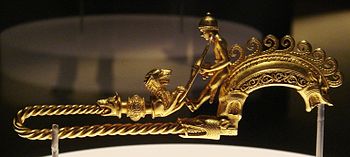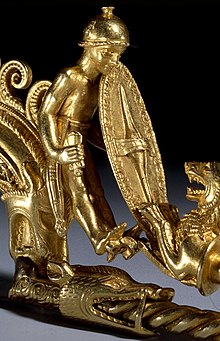
The British Museum is a public museum dedicated to human history, art and culture located in the Bloomsbury area of London. Its permanent collection of eight million works is among the largest and most comprehensive in existence. It documents the story of human culture from its beginnings to the present. The British Museum was the first public national museum in the world.
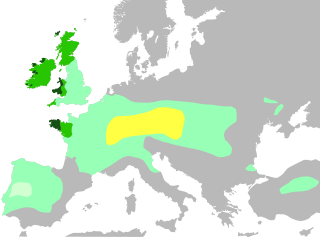
The Celts or Celtic peoples are a collection of Indo-European peoples in Europe and Anatolia, identified by their use of Celtic languages and other cultural similarities. Historical Celtic groups included the Britons, Boii, Celtiberians, Gaels, Gauls, Gallaeci, Galatians, Lepontii and their offshoots. The relation between ethnicity, language and culture in the Celtic world is unclear and debated; for example over the ways in which the Iron Age people of Britain and Ireland should be called Celts. In current scholarship, 'Celt' primarily refers to 'speakers of Celtic languages' rather than to a single ethnic group.

A torc, also spelled torq or torque, is a large rigid or stiff neck ring in metal, made either as a single piece or from strands twisted together. The great majority are open at the front, although some had hook and ring closures and a few had mortice and tenon locking catches to close them. Many seem designed for near-permanent wear and would have been difficult to remove. Torcs are found in the Scythian, Illyrian, Thracian, Celtic, and other cultures of the European Iron Age from around the 8th century BC to the 3rd century AD. For the Iron Age Celts, the gold torc seems to have been a key object. It identifies the wearer as a person of high rank, and many of the finest works of ancient Celtic art are torcs. The Celtic torc disappears in the Migration Period, but during the Viking Age torc-style metal necklaces, now mainly in silver, came back into fashion. Torc styles of neck-ring are found as part of the jewellery styles of various other cultures and periods.
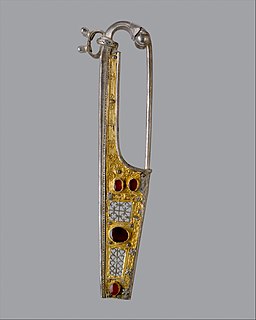
A brooch is a decorative jewelry item designed to be attached to garments, often to fasten them together. It is usually made of metal, often silver or gold or some other material. Brooches are frequently decorated with enamel or with gemstones and may be solely for ornament or serve a practical function as a clothes fastener. The earliest known brooches are from the Bronze Age. As fashions in brooches changed rather quickly, they are important chronological indicators. In archaeology, ancient European brooches are usually referred to by the Latin term fibula.

The Hallstatt culture was the predominant Western and Central European culture of Late Bronze Age from the 12th to 8th centuries BC and Early Iron Age Europe from the 8th to 6th centuries BC, developing out of the Urnfield culture of the 12th century BC and followed in much of its area by the La Tène culture. It is commonly associated with Proto-Celtic populations. Older assumptions of the early 20th century of Illyrians having been the bearers of especially the Eastern Hallstatt culture are indefensible and archeologically unsubstantiated.
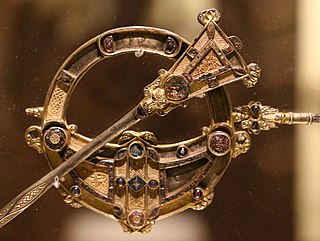
The Tara Brooch is an Irish Celtic brooch, dated to the late-7th or early-8th century, of the pseudo-penannular type. It is made from bronze, silver and gold, with a head formed from a circular ornate ring that is highly decorated on both sides. Its upper half is hollow while the lower half is solid with fused terminals. The brooch was constructed from numerous individually made pieces, and its front and reverse sides are both decorated with around 50 inserted cast panels containing highly ornate filigree. The borders and terminals contain multiple panels holding multi-coloured studs, interlace patterns, filigree and Celtic spirals. The brooch is widely considered the most complex and ornate of its kind, and would have been commissioned to be worn as a fastener for the cloak of a high ranking cleric or as ceremonial insignia of high office for a High King of Ireland in Irish Early Medieval society.

Filigree is a form of intricate metalwork used in jewellery and other small forms of metalwork.

Celtic art is associated with the peoples known as Celts; those who spoke the Celtic languages in Europe from pre-history through to the modern period, as well as the art of ancient peoples whose language is uncertain, but have cultural and stylistic similarities with speakers of Celtic languages.

A fibula is a brooch or pin for fastening garments, typically at the right shoulder. The fibula developed in a variety of shapes, but all were based on the safety-pin principle. Unlike most modern brooches, fibulae were not only decorative; they originally served a practical function: to fasten clothing for both sexes, such as dresses and cloaks. In English, "fibula" is not a word used for modern jewellery, but by archaeologists, who also use "brooch", especially for types other than the ancient "safety pin" types, and for types from the British Isles.

The Cheste hoard is an Iberian hoard discovered near the town of Cheste, Valencia, Spain, in 1864. Dating to about 200 BCE, the hoard was found buried in two pots and contained gold jewellery, silver coins and silver ingots. It is currently held in the Valencia History Museum.

The Winchester Hoard is a hoard of Iron Age gold found in a field in the Winchester area of Hampshire, England, in 2000, by a retired florist and amateur metal detectorist, Kevan Halls. It was declared treasure and valued at £350,000—the highest reward granted under the Treasure Act 1996 at that time.

The Celtic brooch, more properly called the penannular brooch, and its closely related type, the pseudo-penannular brooch, are types of brooch clothes fasteners, often rather large; penannular means formed as an incomplete ring. They are especially associated with the beginning of the Early Medieval period in Ireland and Britain, although they are found in other times and places—for example, forming part of traditional female dress in areas in modern North Africa.
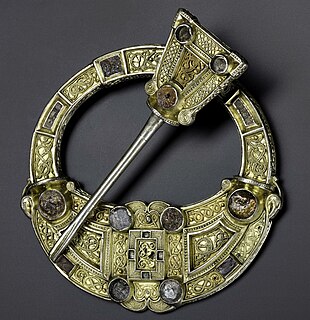
The Hunterston Brooch is a highly important Celtic brooch of "pseudo-penannular" type found near Hunterston, North Ayrshire, Scotland, in either, according to one account, 1826 by two men from West Kilbride, who were digging drains at the foot of Goldenberry Hill, or in 1830. It is now in the National Museum of Scotland, Edinburgh. Made within a few decades of 700 AD, the Hunterston Brooch is cast in silver, gilt, and set with pieces of amber, and decorated with interlaced animal bodies in gold filigree. The diameter of the ring is 12.2 cm, and in its centre there is a cross and a golden glory representing the Risen Christ, surrounded by tiny bird heads. The pin, which is broken, can travel freely around the ring as far as the terminals, which was necessary for fastening; it is now 13.1 cm long, but was probably originally 15 cm or more.

The Londesborough Brooch is a Celtic pseudo-penannular brooch from Ireland. Dating from the late eighth or early ninth century, it is a particularly elaborate example of a dress fastener dated to Ireland's artistic golden age, when objects such as the Tara Brooch and Ardagh Chalice were produced. Since 1888, it has been part of the British Museum's collection.

The Basse Yutz Flagons are a pair of Iron Age ceremonial drinking vessels that date from the mid 5th century BCE. Since their discovery in ill-documented circumstances in the 1920s and their subsequent purchase by the British Museum, they have been described as "great masterpieces" that "combine most of the key features of early Celtic Art". They are in many respects very similar to the Dürrnberg Flagon found in Austria.

The Cordoba Treasure, or Tesoro de Córdoba in Spanish, is the name of a major Iron Age silver hoard found on the outskirts of the city of Córdoba, Spain in 1915. The entire treasure was purchased by the British Museum in 1932, where it has been on public display ever since.

The Ourense Torcs are a pair of Iron Age gold torc neck rings found near Ourense in Northwest Spain in the 1950s. They were acquired by the British Museum in 1960.

The Breadalbane Brooch is a silver and gilt Celtic penannular brooch probably made in Ireland, but later altered and then found in Scotland. Probably dating to the 8th century, with 9th-century alterations, it is an intricately designed, silver-gilt dress fastener that is closely related to a select group of brooches that were produced in Ireland and Britain during the 'golden age' of late Celtic art. The brooch has been in the British Museum since 1919, and is normally on display.

A disc fibula or disc brooch is a type of fibula, that is, a brooch, clip or pin used to fasten clothing that has a disc-shaped, often richly decorated plate or disc covering the fastener. The terms are mostly used in relation to the Middle Ages of Europe, especially the earlier part of the period. They were the most common style of Anglo-Saxon brooches.

The Rogart Brooch is a large penannular brooch of Pictish origin, dated to the eighth century. Characteristic of contemporary Pictish brooches, it contains three-dimensional bird-head inserts formed with glass.
